This man created crash test dummies — here's his amazing story
Cleveland-born Samuel Alderson (1914-2005) created crash test dummies for the auto industry, drastically improving driver safety.
Samuel W. Alderson is the genius who made dummies smart.
The California inventor parlayed a knack for tinkering in his old man’s sheet metal shop into a gift for making highways safer here in America and around the world.
A prolific producer of cutting-edge military hardware in World War II, Alderson is most famous as the father of the crash test dummy.
In scientific circles, these objects are known as anthropomorphic test devices — a more accurate indication of their robust capabilities.
MEET THE AMERICAN WHO FIRST PLANTED APPLES IN THE COLONIES: WILLIAM BLAXTON, ECCENTRIC SETTLER
"Sam Alderson was driven by a passion to save lives by using crash test dummies that produce data [that] engineers use to design safer vehicles," Chris O’Connor, president and CEO of Humanetics, a company founded by Alderson with headquarters in Farmington Hills, Michigan, told Fox News Digital.
The inventor’s life intersected with a fascinating sweep of history, from the dawn of the atomic age to modern pop culture.
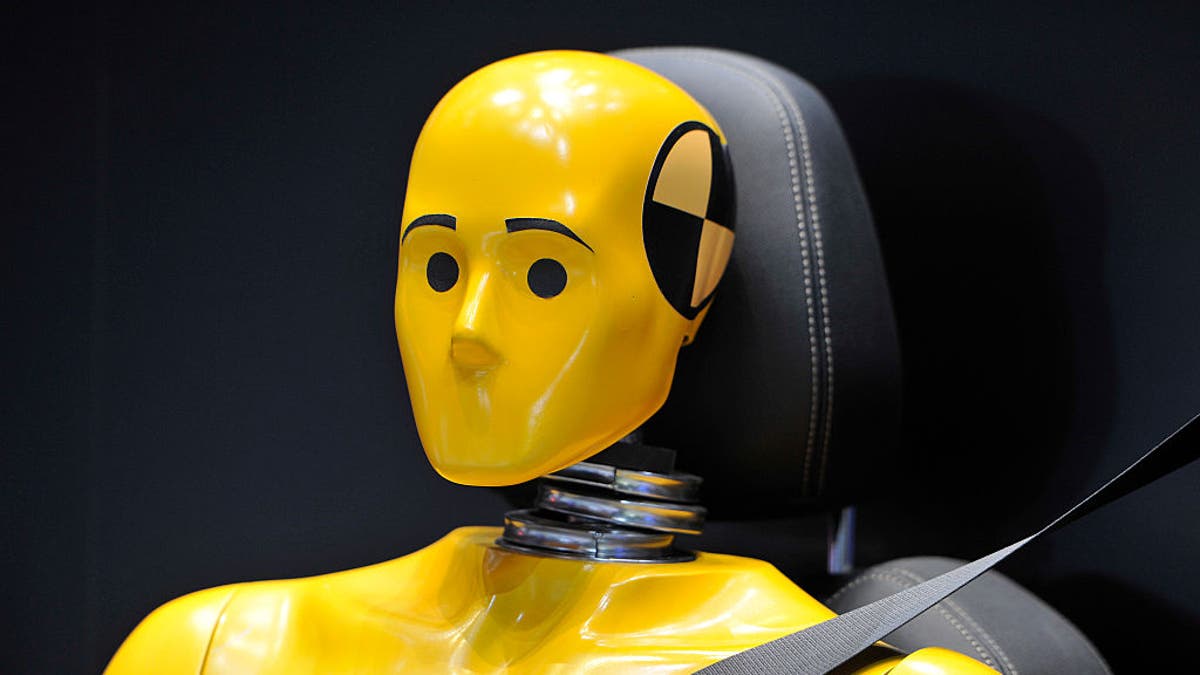
A crash test dummy is displayed during the Geneva Motor Show 2016 on March 2, 2016, in Geneva, Switzerland. (Photo by Harold Cunningham/Getty Images)
Alderson studied at the University of California Berkeley under renowned physicist J. Robert Oppenheimer, who led the American atomic bomb program in World War II.
"I am become death," Oppenheimer said chillingly following the first successful atomic bomb test in New Mexico in July 1945, quoting the influential Hindu text the Bhagavad-Gita.
His protégé Alderson encouraged life.
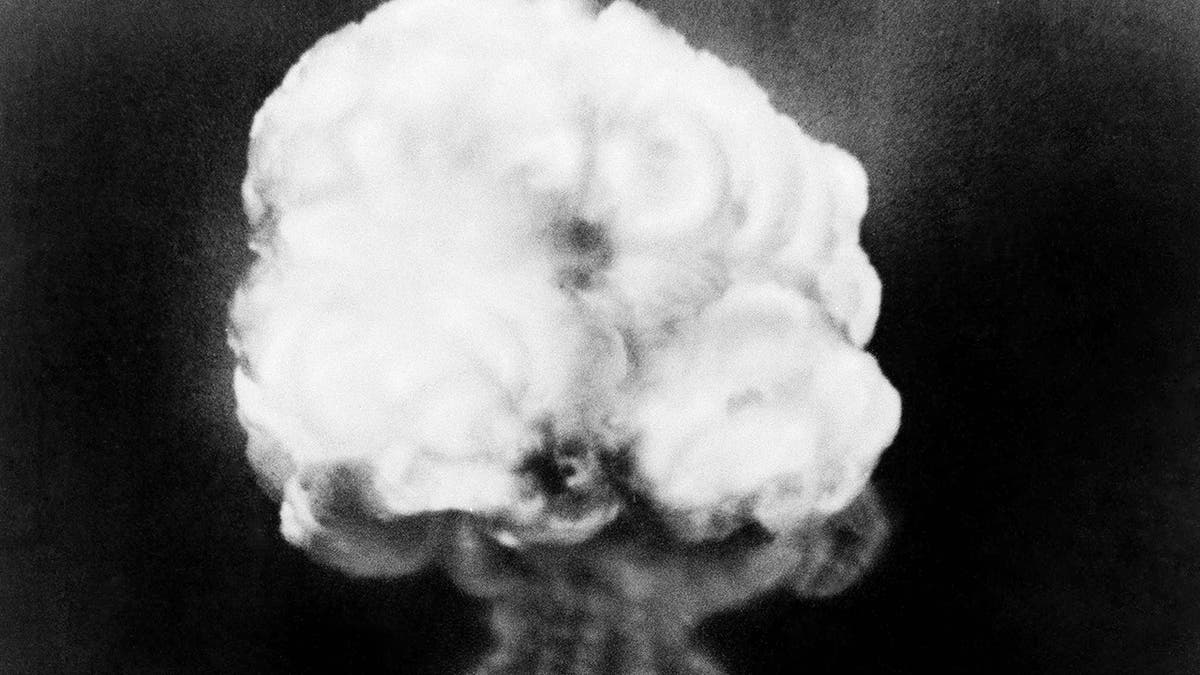
This July 16, 1945, photo shows the mushroom cloud of the first atomic explosion at Trinity Test Site, New Mexico. Auto-safety pioneer and crash test dummy inventor Sam Alderson studied under atomic bomb creator and physicist J. Robert Oppenheimer. (Associated Press)
His invention also made testing vehicles a much less gruesome experience for researchers.
Before crash test dummies entered the lab, animals and human cadavers were used in auto crash experiments.
"While useful in collecting basic data, [cadavers] lacked the durability required for repeated trials," the International Society of Biometrics notes drolly in its biography of Alderson.
PEPPER-SPRAYING ARMORED CADILLAC ESCALADE IS OUT FOR VENGEANCE
Crash test dummies today are made from a variety of materials: stainless steel or aluminum "bones," rubber cartilage for neck vertebrae and vinyl composites for flesh.
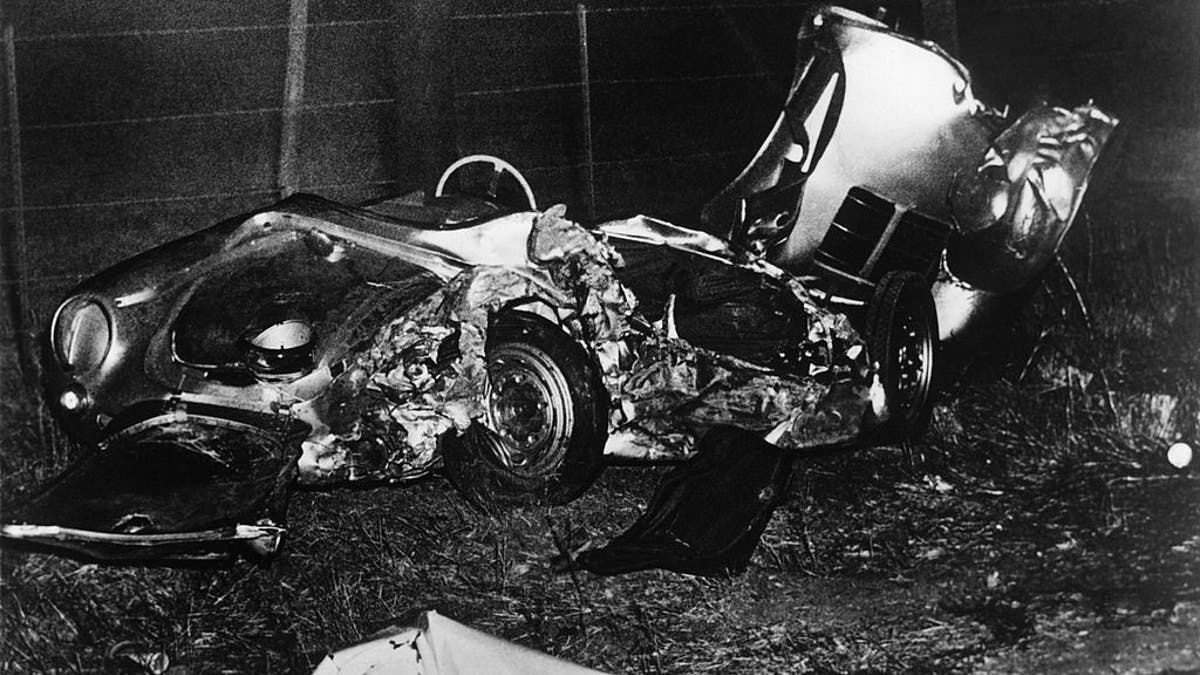
The mangled wreck of actor James Dean's Porsche 550 Spyder after his fatal crash on September 30, 1955, near Cholame, California. (Photo by Michael Ochs Archives/Getty Images)
"We’ve come a long way," Raul Arbelaez, vice president of the Vehicle Research Center at Insurance Institute for Highway Safety, told Fox News digital.
Alderson's inventions helped win World War II
Samuel Alderson was born in Cleveland, Ohio, in 1914. His family moved to California when he was a young boy.
He "graduated from high school at the age of 15 and attended several colleges including Reed College, the California Institute of Technology and the University of California, Berkeley," writes the Inventors Hall of Fame, which inducted Alderson in 2013.
MEET THE AMERICAN WHO INVENTED THE MOTOR HOME
He reportedly never completed his doctorate at Cal. Still, he found plenty of work developing military technology for Uncle Sam in World War II.
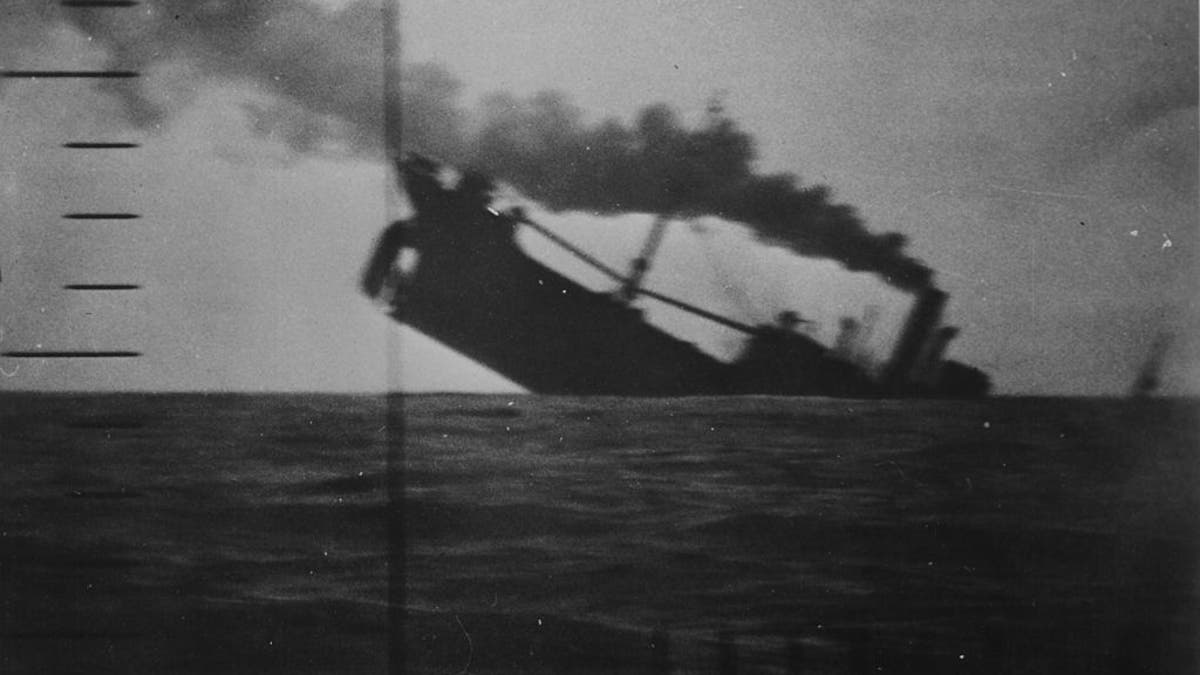
A view through the periscope of the American submarine USS Wahoo (SS-238) of its target, a Japanese merchant ship, sinking in the Pacific, during World War II, 1942. Crash test dummy inventor Samuel Alderson helped develop military technology for the U.S. government in World War II, including improved periscopes on submarines. (Photo by US Navy/Museum of Science and Industry, Chicago/Getty Images)
"He helped develop an optical coating to enhance vision in submarine periscopes at dawn and dusk, helped devise electronic equipment to aid planes in dropping depth charges on German submarines, and worked on missile guidance systems," the Los Angeles Times reported in his obituary in 2005.
He founded Alderson Research Laboratories in 1952, later to become Humanetics.
Today it's a leading provider of crash test dummies.
"Before crash test dummies, animals and human cadavers were used in auto crash experiments."
"The company soon won a contract to create an anthropomorphic dummy for testing air and spacecraft ejection seats, helmets and restraint systems," Humanetics writes in its history of the company. "Until then, the standard test protocols used flour sacks and sandbags."
Alderson's dummies were used by NASA in the Apollo program. He patented a battery-powered prosthetic arm in 1952, a radiation exposure test dummy in 1961, and a synthetic wounds dummy for emergency training in 1962.
His most important innovation came in response to the growing human carnage on the open American road.
Unsafe at any speed
Americans were killed in shocking numbers in auto accidents in the 1950s and 1960s.
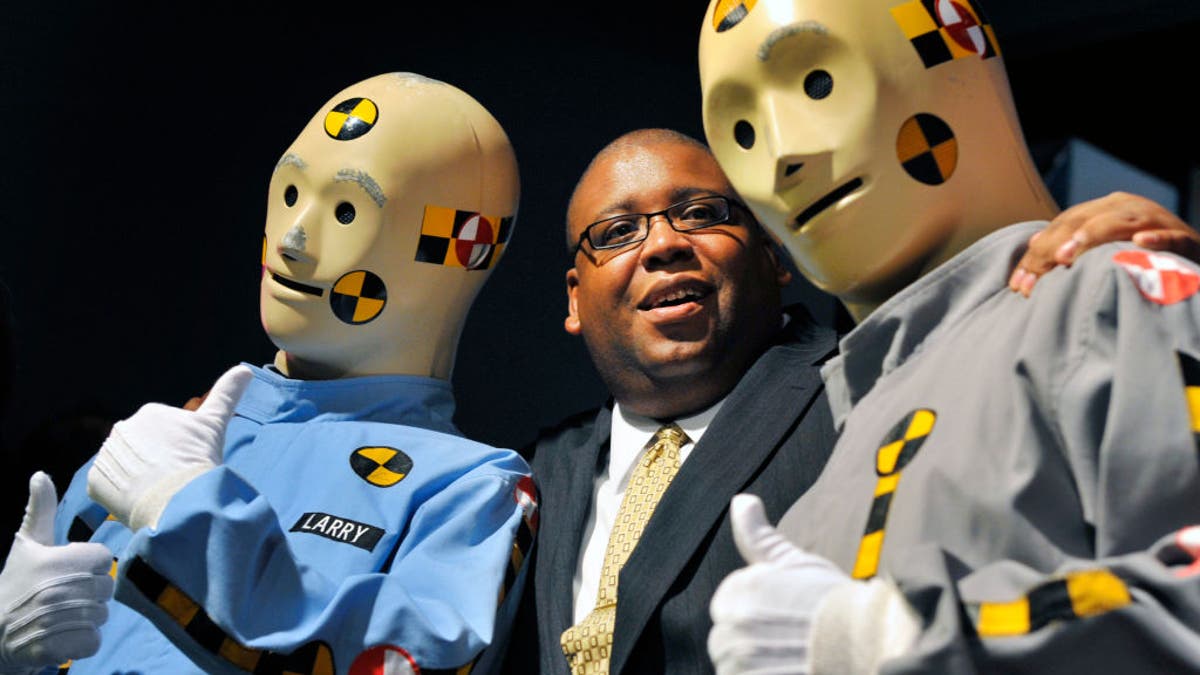
The Vince and Larry crash test dummy public service campaign was launched in 1985. Donated artifacts were welcomed at a ceremony at the Smithsonian American History museum on July, 14, 2010, in Washington, DC., where NHTSA Administrator David Strickland (above, center) posed for pictures with the original crash test dummies. (Photo by Bill O'Leary/The Washington Post via Getty Images)
The auto fatality rate topped 25 people per 100,000 Americans annually through the 1960s — more than twice the traffic death rate today.
A long list of celebrity tragedies kept the crisis in the headlines. Iconic actor James Dean was killed in a California street race in 1955 at the height of his budding fame.
Country crooner Patsy Cline was thrown into the windshield of her car in a Nashville collision in 1961. She miraculously survived but suffered facial lacerations and permanent scars.
The auto fatality rate through the 1960s was more than twice the rate of road fatalities today.
Sex symbol actress Jayne Mansfield was killed instantly in a 1967 auto accident in Louisiana.
Her three young children, who were in the back seat, survived. One of her kids, Mariska Hargitay, is an actress today best known for her long-running role in TV series "Law & Order Special Victims Unit."
She still bears scars from the accident 55 years later, reports say.

Pop-culture icon Jayne Mansfield, right, was killed in a gruesome auto accident in 1967. Her daughter, actress Mariska Hargitay, just three years old at the time, survived the crash. (Getty Images)
Americans were driving too fast, they were too often impaired, and they were in vehicles too poorly equipped to protect the human body.
Consumer warrior Ralph Nader exposed the tragedy on the American highway in his landmark 1965 book, "Unsafe at any Speed." His explosive expose took the auto industry to task for failing to protect its customers.
Public outrage forced both the government and the auto industry into action. The Department of Transportation was established in 1966, while the National Highway Traffic Safety Administration was created in 1970.
The agencies tackled the deaths on the road statutorily.

Ralph Nader, founder of Public Citizen Inc., holds a copy of his book "Unsafe at any Speed" before a Senate Consumer Protection, Product Safety, and Insurance Subcommittee hearing in Washington, D.C., on July 17, 2014. (Andrew Harrer/Bloomberg via Getty Images)
Samuel Alderson tackled the problem scientifically.
"Mr. Alderson produced the first dummy, called the V.I.P., built specifically for automotive testing," writes the International Society of Biometrics.
"With the dimensions of an average adult man, the dummy had a steel rib cage, articulated joints and a flexible neck and lumbar spine. Cavities held instruments for collecting data."
Each sensor in a dummy can record up to 20,000 data samples per second.
The device’s dim-wit name shortchanges its capabilities. The dummies of today are actually highly advanced research tools.
Each sensor in a dummy can record up to 20,000 data samples per second, said Arbelaez of the Vehicle Research Center at Insurance Institute for Highway Safety.

Samuel Alderson received a patent for the anthropomorphic dummy for use in vehicle crash testing (crash test dummy) on April 14, 1981. (U.S. Patent and Trademark Office)
The data provided by crash test dummies has led to improvements in everything from car design to airbags and safety belts.
Seat belts are much more complex than people realize, said Arbelaez.
The most modern restraints are built with dual-load limiters designed to provide both the optimum amount of give and tension to best protect a human body.
GOING SOLO: RENAULT REVEALS 1-PASSINGER ‘CAR’ WITHOUT SEATBELTS
Crash test dummies made each safety advance possible.
The auto fatality rate has declined steadily since the introduction of crash test dummies. There was a COVID-era spike in the auto death rate in 2021. But driving in general is safer than it's ever been. Other factors have played a major role, too, most notably the widespread use of seat belts.
Crash test dummy as pop-culture icon
Samuel Alderson died on February 11, 2005, in Marina del Rey, California, after he battled myelofibrosis and pneumonia.

A crash test dummy is displayed during the Geneva Motor Show 2016 on March 2, 2016, in Geneva, Switzerland. (Photo by Harold Cunningham/Getty Images)
His legacy lives on most notably in his anthropomorphic test devices — which will continue to save lives for the foreseeable future, say industry experts.
The industry goal, the purpose of Alderson’s dummies, said Arbelaez, "is to make overall deaths go down to zero." Not likely, he added — but still the goal.
Alderson’s crash test dummy has enjoyed another role in American society far from the test lab; it's a future the inventor never could have foreseen.
His largely faceless, emotionless smart dummies have become pop-culture icons.

Vocalist Ellen Reid and guitarist Brad Roberts of Crash Test Dummies perform at Bottom Of The Hill on August 15, 2022, in San Francisco. (Photo by Miikka Skaffari/Getty Images)
Crash test dummy tandem "Vince" and "Larry" were featured in a series of highly visible public-service TV ads in the 1980s, produced by the U.S. Department of Transportation, encouraging people to wear seat belts.
Tyco released a line of Incredible Crash Dummies action figures in the 1990s. The toys inspired the Fox Kids animated children’s television show, "The Incredible Crash Dummies," in 1993.
CLICK HERE TO SIGN UP FOR OUR LIFESTYLE NEWSLETTER
The Canadian band Crash Test Dummies charted around the world in the 1990s with tracks such as "Superman's Song" and "Mmm Mmm Mmm Mmm," featuring the legendarily deep voice of lead singer Brad Roberts.
A friend in medical school suggested the name to the band after watching a film in class that featured test dummies — not widely known at the time — instead of cadavers.
"It thought it was a great name. It was an ironic name," Roberts told Fox News Digital.
The global success of the band, which still tours today, gave Alderson's quirky invention a level of pop-culture recognition rare for what is essentially a data-gathering computer.
CLICK HERE TO GET THE FOX NEWS APP
Writes Humanetics in its biography of Alderson: "By far his most consequential work was the invention and continuous improvement of automotive crash test dummies, leading to an estimated 330,000 lives spared and millions of debilitating injuries prevented around the world."
To read more stories in this unique "Meet the American Who…" series from Fox News Digital, click here.









































